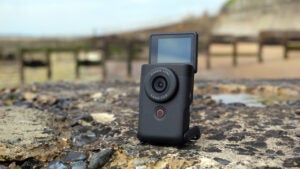
Despite some impressive aspects, Canon’s first vlogging camera feels like a white elephant. Its quality and features aren’t good enough to convince budding content creators to replace their smartphones, while those looking to produce professional-looking videos will do far better by saving up a little more for a mirrorless camera.
Pros
- Lightweight pocket-sized build
- Good build quality and sturdy stand
- Image quality beats phones in certain conditions
Cons
- 9:16 shooting requires rotating the camera
- Very small LCD screen
- Patchy autofocus performance
Key Features
-
Wide-angle lens:19mm equivalent fixed focal length lens with maximum F2.8 aperture -
1-inch sensor:15.2MP 1.0-type back-illuminated CMOS sensor for photos and video -
Small, lightweight buildWeighs just 211g and is compact enough to fit in a trouser pocket
Introduction
Canon isn’t about to let Sony hog the vlogging camera market. The Canon PowerShot V10 is the company’s first camera designed specifically for vloggers; it’s tiny and lightweight, comes with a wide-angle lens, face-tracking autofocus and image stabilisation and gives users the ability to record 4K video at up to 30fps (or 1080p video at up to 60fps).
The thing is, most of the above are traits shared by a decent smartphone – something that I imagine almost every prospective vlog superstar already owns. To succeed, the PowerShot V10 needs to be markedly better than a phone, because despite being an entry-level product it’s still a sizeable cash investment. Does it do so? We’ve been putting it through its paces for a few days, so let’s dive in and find out.
Design and Handling
- Palm-sized build
- Built-in kickstand
- Tilt-and-flip LCD touchscreen
Pulling the PowerShot V10 out of its box, I was immediately impressed. Its overall design is unusual but genuinely clever: the solid and sturdy built-in kickstand for instance, which allows you to prop it up on a desktop for filming to-camera pieces (or for use as a webcam).
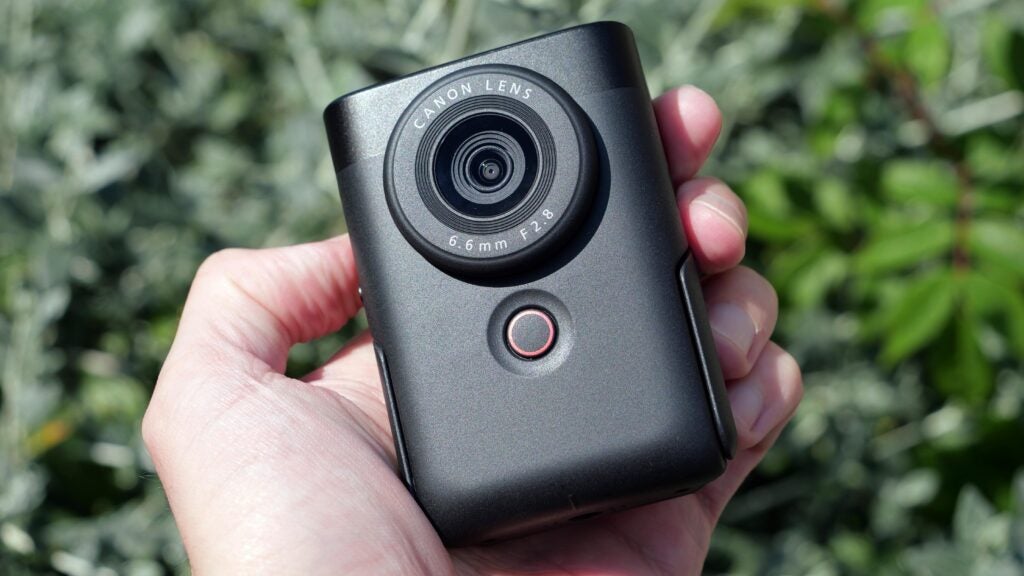
The V10 is very lightweight, small enough to fit in a trouser pocket and a cinch to hold one-handed, although a tripod mount on the bottom means you can easily attach a vlog handle if you want a bit more stabilisation. It’s chunkier than a smartphone, but not as tall and overall it feels extremely portable. It’s also solidly built – if not waterproof or rugged. So far, so good.
The touchscreen is the first red mark against it, though. While I liked that it flips up 180 degrees, allowing it to face forwards, backwards and somewhere in between, at 2 inches in width it feels very small compared to other cameras (which typically offer 3-inch displays) and phones (which are usually much larger). That means you can sometimes struggle to see it from a distance as short as an arm’s length, particularly when you’re outdoors on a sunny day. More than once this left us with footage that was unfocussed or poorly framed, so it’s certainly an issue to be aware of.
There’s a minimalist control layout, with a single large record/shutter button on the front and several smaller buttons on the back for controlling the power and settings. The screen also offers a host of touch controls, and overall I found using the camera to be a pleasant process. That’s not to say it couldn’t be improved, and a physical button to instantly switch between still and video shooting was much missed – as it stands, you need to use the touchscreen to do this and it takes far too long.
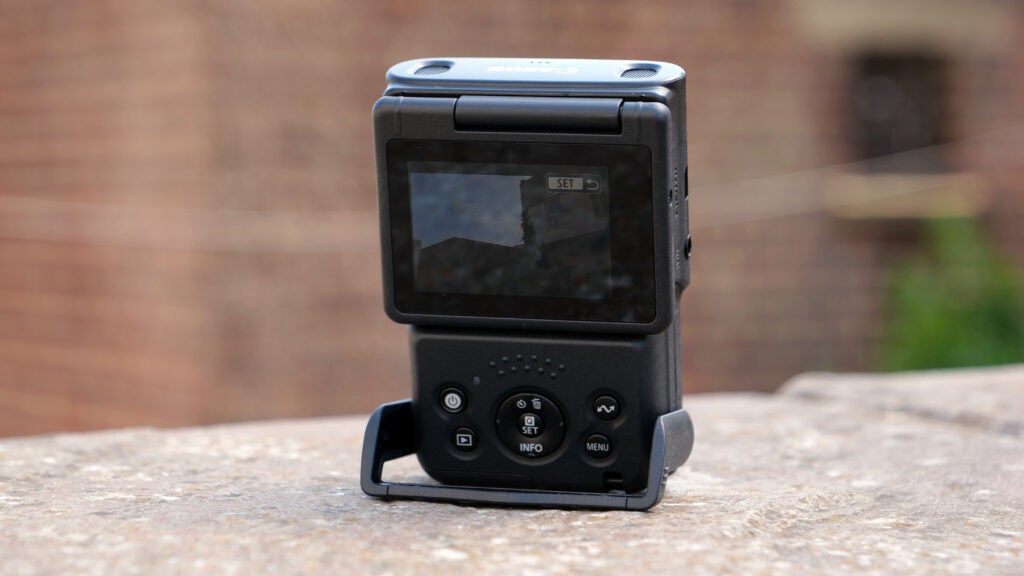
Connectivity is simple but adequate. Wireless duties are handled well enough by 2.4GHz Wi-Fi and Bluetooth 4.2 (and given the vlog-first nature of the camera, I suspect a lot of buyers will be making use of them to move content onto phones and then social media), while on the wired front there’s USB-C (which can be used for webcam streaming as well as charging and data transfer), micro HDMI and a 3.5mm mic input. There’s also a slot for a microSD card, and with no on-board storage you’ll need one – preferably a fast one (V30 or more) if you’re shooting 4K video.
Features
- Face-tracking autofocus
- Two-level electronic image stabilisation
- Webcam functionality
Vloggers spend much of the time filming themselves while walking around, so it’s little wonder that Canon has equipped the PowerShot V10 with features to support this specific type of shooting. We’ve already mentioned the lightweight, palm-sized build, the front-facing screen and front-mounted record button, but there’s also electronic image stabilisation to counteract camera shake and autofocus that can be set to recognise and track human faces.
While these might sound like killer features, in practice they’re a touch undercooked. The stabilisation works well at times (when filming yourself) but can be jerky in other moments (when you turn it around and film ‘POV’ content while walking), and at its most effective setting the frame is cropped quite severely, leaving you with less space to work with. The autofocus was also patchy, at times recognising faces and at others deciding the background was more interesting, leaving the subject fuzzy and soft.
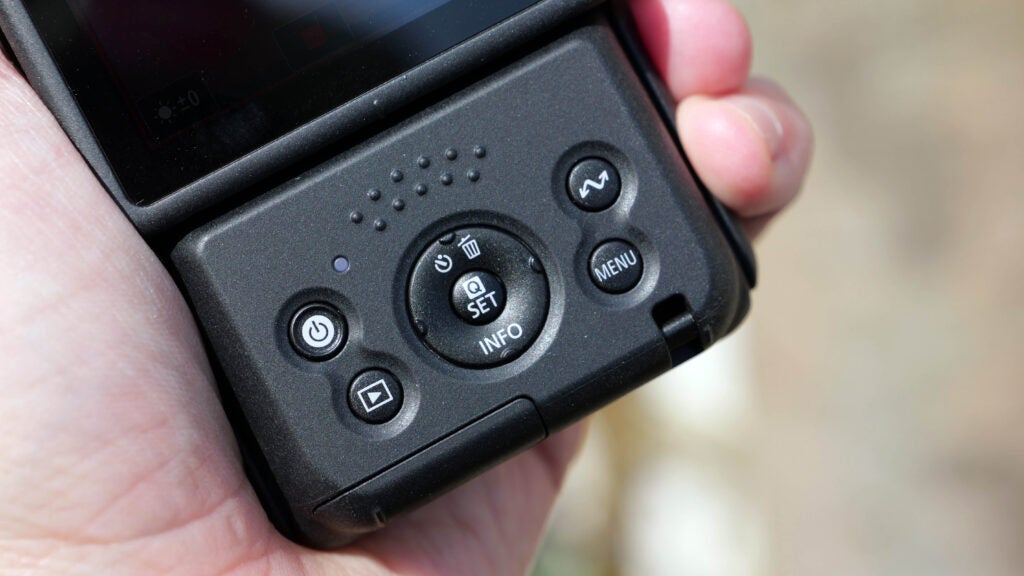
Even if they’re not resounding successes, these features are arguably one area where the PowerShot V10 does beat or at least match most smartphones. Another point is that it functions surprisingly well as a webcam: hook it up to your computer via USB and you can immediately use it for Zoom calls and Twitch streaming sessions, with minimal fuss involved.
Finally, it features a built-in rechargeable battery that offers about an hour of video recording time. You can also use the USB-C port as a permanent power supply, so if you’re filming longer clips consider hooking up a large-capacity power bank or similar.
Video and Photo Quality
- 4K at 30fps or 1080p at 60fps
- 15.2MP still photos
- Built-in ND filter
With its 1-inch back-illuminated CMOS sensor, the PowerShot V10 has greater raw imaging power than most smartphones. That’s the theory anyway, but I found the performance to be a mixed bag. In the right lighting conditions, footage and photos look impressively sharp and rich, but the lack of on-board lighting means you need to be careful when and where you’re filming if you want to maintain this level of quality.
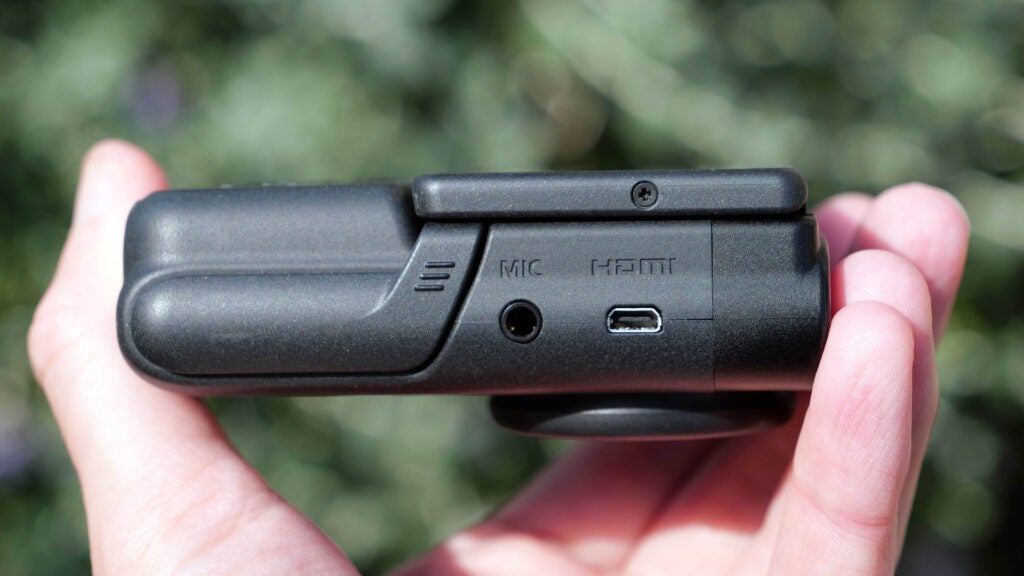
Some kind of LED light would have been a useful addition to the features list, as would the ability to quickly shoot 9:16 portrait content without turning the camera 90 degrees. With TikTok and its imitators arguably being the most popular vlogging platforms at the moment, including it would seem like an easy win which suggests that Canon doesn’t really understand its target market.
The wide-angle lens feels like a sensible choice for the most part, as it provides a good field-of-view for selfies and vlogs. It’s not versatile though, and when shooting smaller subjects beyond a metre or two away I found that they tended to feel lost in the wide frame, so you’ll need to work within the V10’s limitations to get decent results. One nice feature however is a built-in ND filter for outdoor filming in direct sunlight.
The twin, top-mounted microphones do an acceptable job in most circumstances, seeming particularly adept at picking up voices. They do suffer from wind noise outdoors, but thankfully some fuzzy stick-on windshields are supplied in the box; these aren’t as secure as the one you find on Sony’s vlogging compacts, however.
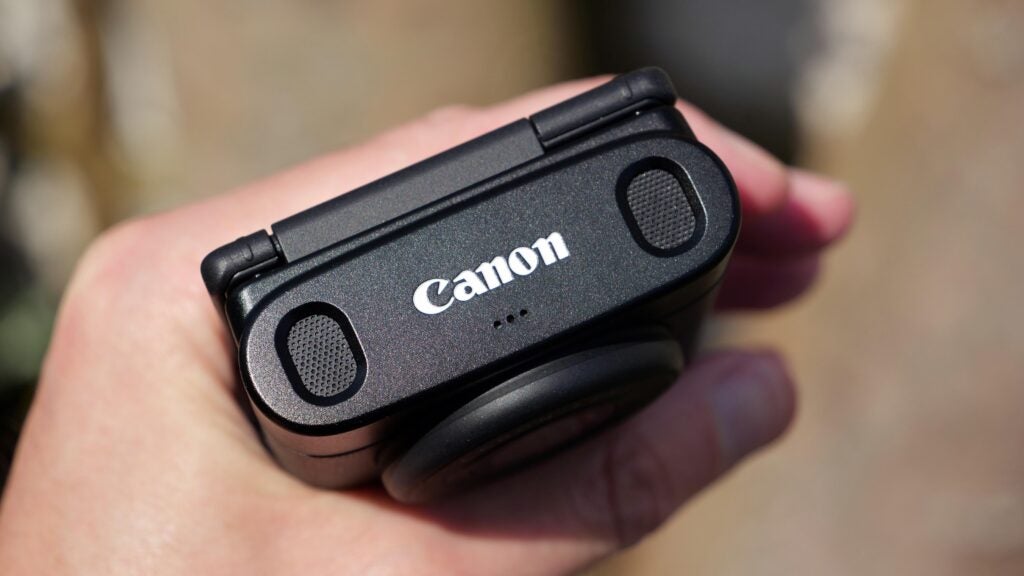
Latest deals
Should you buy it?
Your smartphone isn’t up to scratch: If your smartphone’s camera is poor and you need a cheap gateway into vlogging, the V10 isn’t a bad one. It’s small, lightweight and overall performance is adequate.
You own a high-end handset: If you already own a good quality smartphone, it makes more sense to stick to using that and save your money for a camera that represents a genuine upgrade.
Final Thoughts
The Canon PowerShot V10 feels like a camera out of time. Had it been released a couple of years ago, it might have had some genuine appeal but today – with the likes of Sony and GoPro having already cornered the small vlogging camera market – it’s too quirky and underpowered to replace a decent smartphone, let alone a mirrorless camera.
It’s rare that Canon delivers a bad product, and I suspect the company may have other, more powerful and flexible vlogging models in the pipeline. However, it’s worth remembering that you don’t need a ‘vlog camera’ to make vlogs: you can use any camera, and most cameras out there will do a better job than the V10. Our advice to would-be vloggers: save up a little more money, buy a cheap mirrorless camera instead – or if you must get a compact all-in-one vlog machine, take a look at either the GoPro Hero 11 or the Sony ZV-E1.
How we test
We test every camera we review thoroughly. We use set tests to compare features properly and we use it as our main device over the review period. We’ll always tell you what we find and we never, ever, accept money to review a product.
Used the camera for a week
FAQs
Yes, you can connect the PowerShot V10 to a computer or a laptop and use it for video calls or livestreaming.
There is a 3.5mm jack for connecting and using external microphones.
Full specs
Sustainability
Trusted Reviews’ holds the fact that global warming is not a myth as a core value and will continuously endeavour to help protect our planet from harm in its business practices.
As part of this mission, whenever we review a product we send the company a series of questions to help us gauge and make transparent the impact the device has on the environment.
We currently haven’t received answers to the questions on this product, but will update this page the moment we do. You can see a detailed breakdown of the questions we ask and why in our sustainability info page.
The post Canon PowerShot V10 appeared first on Trusted Reviews.
Author: Sam Kieldsen
This article comes from Trusted Reviews and can be read on the original site.
